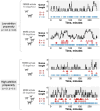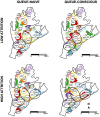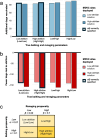Enhancing mass vaccination programs with queueing theory and spatial optimization
- PMID: 39776482
- PMCID: PMC11703910
- DOI: 10.3389/fpubh.2024.1440673
Enhancing mass vaccination programs with queueing theory and spatial optimization
Abstract
Background: Mass vaccination is a cornerstone of public health emergency preparedness and response. However, injudicious placement of vaccination sites can lead to the formation of long waiting lines or queues, which discourages individuals from waiting to be vaccinated and may thus jeopardize the achievement of public health targets. Queueing theory offers a framework for modeling queue formation at vaccination sites and its effect on vaccine uptake.
Methods: We developed an algorithm that integrates queueing theory within a spatial optimization framework to optimize the placement of mass vaccination sites. The algorithm was built and tested using data from a mass dog rabies vaccination campaign in Arequipa, Peru. We compared expected vaccination coverage and losses from queueing (i.e., attrition) for sites optimized with our queue-conscious algorithm to those used in a previous vaccination campaign, as well as to sites obtained from a queue-naïve version of the same algorithm.
Results: Sites placed by the queue-conscious algorithm resulted in 9-32% less attrition and 11-12% higher vaccination coverage compared to previously used sites and 9-19% less attrition and 1-2% higher vaccination coverage compared to sites placed by the queue-naïve algorithm. Compared to the queue-naïve algorithm, the queue-conscious algorithm placed more sites in densely populated areas to offset high arrival volumes, thereby reducing losses due to excessive queueing. These results were not sensitive to misspecification of queueing parameters or relaxation of the constant arrival rate assumption.
Conclusion: One should consider losses from queueing to optimally place mass vaccination sites, even when empirically derived queueing parameters are not available. Due to the negative impacts of excessive wait times on participant satisfaction, reducing queueing attrition is also expected to yield downstream benefits and improve vaccination coverage in subsequent mass vaccination campaigns.
Keywords: One Health; emergency preparedness; facility location; mass vaccination; queueing theory; rabies; spatial optimization; zoonosis.
Copyright © 2024 Xie, Rieders, Changolkar, Bhattacharya, Diaz, Levy and Castillo-Neyra.
Conflict of interest statement
The authors declare that the research was conducted in the absence of any commercial or financial relationships that could be construed as a potential conflict of interest.
Figures






Update of
-
Enhancing Mass Vaccination Programs with Queueing Theory and Spatial Optimization.medRxiv [Preprint]. 2024 Jul 9:2024.06.14.24308958. doi: 10.1101/2024.06.14.24308958. medRxiv. 2024. Update in: Front Public Health. 2024 Dec 24;12:1440673. doi: 10.3389/fpubh.2024.1440673. PMID: 38947058 Free PMC article. Updated. Preprint.
Similar articles
-
Enhancing Mass Vaccination Programs with Queueing Theory and Spatial Optimization.medRxiv [Preprint]. 2024 Jul 9:2024.06.14.24308958. doi: 10.1101/2024.06.14.24308958. medRxiv. 2024. Update in: Front Public Health. 2024 Dec 24;12:1440673. doi: 10.3389/fpubh.2024.1440673. PMID: 38947058 Free PMC article. Updated. Preprint.
-
Socio-spatial heterogeneity in participation in mass dog rabies vaccination campaigns, Arequipa, Peru.PLoS Negl Trop Dis. 2019 Aug 1;13(8):e0007600. doi: 10.1371/journal.pntd.0007600. eCollection 2019 Aug. PLoS Negl Trop Dis. 2019. PMID: 31369560 Free PMC article.
-
Optimizing the location of vaccination sites to stop a zoonotic epidemic.Sci Rep. 2024 Jul 10;14(1):15910. doi: 10.1038/s41598-024-66674-x. Sci Rep. 2024. PMID: 38987306 Free PMC article.
-
Review on dog rabies vaccination coverage in Africa: a question of dog accessibility or cost recovery?PLoS Negl Trop Dis. 2015 Feb 3;9(2):e0003447. doi: 10.1371/journal.pntd.0003447. eCollection 2015 Feb. PLoS Negl Trop Dis. 2015. PMID: 25646774 Free PMC article. Review.
-
Rationale and support for a One Health program for canine vaccination as the most cost-effective means of controlling zoonotic rabies in endemic settings.Vaccine. 2017 Mar 23;35(13):1668-1674. doi: 10.1016/j.vaccine.2017.02.014. Epub 2017 Feb 16. Vaccine. 2017. PMID: 28216188 Review.
Cited by
-
Neighborhood Socioeconomic Status and Dog-Mediated Rabies: Disparities in Incidence and Surveillance Effort in a Latin American City.medRxiv [Preprint]. 2025 Apr 3:2025.04.02.25325110. doi: 10.1101/2025.04.02.25325110. medRxiv. 2025. PMID: 40236423 Free PMC article. Preprint.
References
-
- Bleustein C, Rothschild DB, Valen A, Valatis E, Schweitzer L, Jones R. Wait times, patient satisfaction scores, and the perception of care. Am J Manag Care. (2014) 20:393–400. PMID: - PubMed
-
- Rosner E, Lapin T, Garger K. (2021). Hours-long waits reported at Javits center COVID vaccine site in NYC. New York Post. Available at: https://nypost.com/2021/03/02/hours-long-waits-reported-at-javits-center... (Accessed March 2, 2021).
MeSH terms
Substances
Grants and funding
LinkOut - more resources
Full Text Sources

